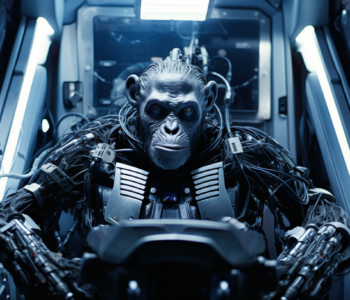 Rainbow Butt Ruminations
Rainbow Butt Ruminations
Will Artificially Intelligent Monkeys Save the Earth?
From the dusty annals of time, humanity has yearned for a Utopian existence—an earthly paradise where peace, prosperity, and happiness prevail. Paradoxically, this dream might be realized not through our endeavors alone, but through an unexpected intersection of technology and evolution: a merging of artificial intelligence (AI) with one of our closest relatives in the animal kingdom, the monkey.
Before delving into the heart of this audacious premise, it’s important to establish a foundation of understanding around two areas. First, let’s explore the extraordinary capabilities of monkeys, and secondly, the rapid strides that have been made in artificial intelligence, particularly with respect to machine learning and neural interfaces.
Monkeys are renowned for their remarkable cognitive abilities, demonstrating complex problem-solving skills and advanced social behaviors that often parallel human capabilities. Research from the Max Planck Institute for Evolutionary Anthropology (2016) underscores this, revealing that monkeys are capable of metacognition—the ability to think about thinking, an attribute once thought exclusive to humans.
In parallel, artificial intelligence has made exponential leaps in cognitive functions. Advanced machine learning algorithms, such as deep learning, have successfully simulated neural networks, allowing them to learn, adapt, and evolve. As of my knowledge cutoff in September 2021, AI has not only beaten humans in complex games like Go and Chess but has shown impressive strides in understanding and generating human language, as demonstrated by AI models like GPT-4.
The fusion of these two domains represents a formidable partnership. Neuralink, an ambitious project by Elon Musk, aims to create high-bandwidth brain-machine interfaces. While initially designed to address neurological disorders, the technology holds promise for broader applications, potentially facilitating direct communication between AI and organic brains.
What might happen if we were to combine these technologies? Could we potentially endow monkeys with augmented intelligence and enhanced problem-solving abilities?
The prospect isn’t as outlandish as it initially appears. Consider the groundbreaking research at Duke University in 2014, where researchers developed a brain-to-brain interface allowing rats to share information directly. Applying this concept to monkeys and AI, it becomes feasible that we could create an intelligent, biotechnological hybrid capable of addressing Earth’s complex challenges.
A highly intelligent, problem-solving monkey, augmented by the limitless processing power and knowledge of an AI, could transcend the bounds of both its species’ intelligence and the restrictions we humans face due to our societal constructs and cognitive biases.
For instance, AI-monkey hybrids, unhindered by the politics and prejudices that often obstruct human progress, could bring fresh, unbiased perspectives to environmental issues. Drawing upon the AI’s vast databases of climatological data and the monkey’s inherent understanding of natural ecosystems, these hybrids could innovate unprecedented solutions to climate change.
Moreover, a lack of acquisitive tendencies in monkeys could foster a more equitable resource distribution model. AI, with its data-driven approach, could help guide such an endeavor, creating a sustainable model that promotes the welfare of all Earth’s inhabitants.
Lastly, given their social nature, these hybrids might help us understand how to build more harmonious societies. Their unique position, as a bridge between nature and technology, could provide valuable insights into creating societies that blend technological advancement with environmental stewardship, a balance we’ve struggled to strike.
While these ideas might appear to be the stuff of science fiction, history has shown us that today’s fiction often becomes tomorrow’s reality. It’s only through exploring audacious ideas like these that we push the boundaries of possibility and inch closer to the Utopia we’ve longed for.
To be clear, this proposal doesn’t suggest abdicating human responsibility for our planet. Instead, it invites us to explore innovative collaborations, envisioning a future where human, AI, and animal intellects coalesce in pursuit of a common goal—a better world for all Earth’s inhabitants.
Harnessing the intellect of monkeys, the power of artificial intelligence, and the innate aspiration of humanity, we can shape a utopia—a world where harmony, understanding, and advancement aren’t merely dreams, but realities we can touch, feel, and experience. It’s high time we let the echo of our collective yearning ring through the corridors of possibility and dare to dream the once unthinkable.